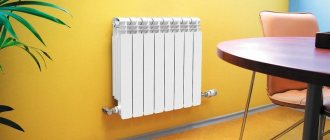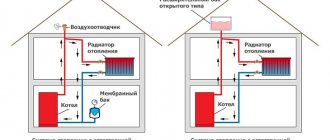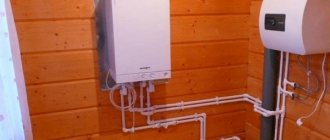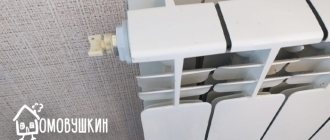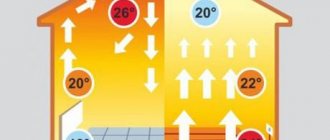“Batteries hardly heat up” - this phrase, or its variants, can often be heard in the cold season. Sometimes such assessments can be purely subjective. But, usually, people complain about problems with the heating system. More often, heating problems occur during periods of severe cold weather and (as a consequence) the most intense operating conditions of heating systems.
Of course, breakdowns of the heating system do occur, but much less often if preparation for the heating season is carried out on time and efficiently. Malfunctions occur when the load on the mechanism or system is maximum. In this case, breakdowns occur more often. However, in addition to emergency failures of the heating system, batteries can become cold for a number of other reasons.
Having reliable information about the causes of cold radiators is useful for both apartment owners and owners of private houses. You should also be aware of the possibilities of optimizing the heating system to increase the efficiency and economy of its operation.
Here is a list of reasons why cold batteries appear in a house or apartment:
Incorrect connections in the heating system
The correct design and installation of the heating system is the basis for the efficiency of space heating and optimization of heat consumption. A common mistake is incorrect installation of the bypass. It should be noted that installing the tap directly on the bypass is prohibited. With this installation, it is possible to shut off the circulation throughout the entire riser if the valves on the battery and the bypass are closed at the same time. This is especially true in an apartment building and with a single-pipe connection scheme.
The number of sections that make up the heating radiator is too large compared to the design one. If necessary, you can connect the radiator “diagonally” or install a “flow extender” on such a radiator. You can make such a bypass - flow extender yourself or purchase a ready-made one.
With a multi-circuit system, balancing valves should be provided during installation in the shorter arm of the system. With such taps you can even out the temperature balance in different parts of the heating system.
What to do?
Check if the battery is connected correctly. Then open the water inlet and outlet taps to full capacity. If you find any malfunctions, repair or replace the components.
Then release the air lock. If that doesn't help, clean the radiators.
After each heating season, check the operation of the shut-off valves. Install Mayevsky taps if they do not exist. If the heat is distributed unevenly, call a specialist.
Important: not all problems can be fixed on your own. If the top of the battery is hot for several days, this is a reason to troubleshoot. If you are not confident in your abilities, call an REP employee.
The best way to make the temperature in heating devices uniform is to replace old models with new ones. Modern bimetallic products have increased heat transfer rates and a reliable design that is not susceptible to corrosion.
Airing the heating system
The most common cause of cold radiators in houses and apartments is air getting into the heating system circuit. As a result of the presence of minor air bubbles, a bubble is formed during the circulation process that blocks the flow. The provided air vent is not always effective.
If the heating system riser is airy, which is understandable when cooling several radiators, you should contact maintenance and call a plumber.
If one of the batteries becomes airy (when the supply pipes are hot and the radiator or part of it is cold), you can bleed off the accumulated air yourself. Modern heating radiators are usually equipped with a Mayevsky tap. To bleed air, such a tap must be opened slightly until water appears. Videos and printed instructions are available on the Internet.
Shut-off valve is faulty
It regulates the movement of the working environment, and also completely or partially blocks it.
This includes the following devices:
- thermal heads,
- valves,
- Ball Valves.
With their help, you can adjust the temperature in the room and reduce costs if a heat meter is provided.
There is an arrow indicator on the taps. It indicates the direction of fluid movement. For the highway to work properly, mistakes must not be made.
In addition, for some types of valves there are requirements regarding their location in space. If the devices are installed incorrectly, the circulation of the coolant is disrupted. As a result, the top of the battery remains hot and the bottom becomes cold.
Clogged heating system riser
A clogged heating system riser in an apartment building is determined by the cooling of heating radiators in several apartments. Typically, such radiators can be located vertically one below the other, depending on the configuration of the specific heating system. Usually, with such a breakdown, the upper floors receive enough heat, and the lower floors freeze. This is especially noticeable when there is a strong minus on the street.
The reasons that lead to clogging of the riser are usually laid down at the installation stage. A decrease in the diameter of the riser pipe by 0.25 compared to the design one leads to clogging with oxides and debris after just a few years.
Removing such a clogged system riser usually requires the work of a qualified team of plumbers. Often, such repairs also require the consent of other residents, including apartments that are not directly affected by the emergency.
What does it depend on?
The temperature curve depends on two quantities:
outside air and coolant. Frosty weather leads to an increase in coolant temperature. When designing a central source, the size of the equipment, building and pipe size are taken into account.
The temperature leaving the boiler room is 90 degrees, so that at minus 23°C, the apartments are warm and have a value of 22°C. Then the return water returns to 70 degrees. Such standards correspond to normal and comfortable living in the house.
Analysis and adjustment of operating modes is carried out using a temperature diagram.
For example, the return of liquid with an elevated temperature will indicate high coolant costs. Underestimated data will be considered a consumption deficit.
Previously, for 10-story buildings, a scheme with calculated data of 95-70°C was introduced. The buildings above had their own chart of 105-70°C. Modern new buildings may have a different layout, at the discretion of the designer. More often, there are diagrams of 90-70°C, and maybe 80-60°C.
Temperature chart 95-70:
Temperature chart
One of the batteries is clogged
A clogged heating system battery can be easily identified by a significant decrease or absence of heating. The entire battery or only part of it may not “heat.” In this case, the riser pipe is clearly warm and there is no air in the system.
Even a new or recently repaired radiator can clog. Oxide, scale and other process debris are especially common in new or recently renovated systems.
Flushing the radiator is quite easy, especially if two American-type taps are installed. Such taps allow you to dismantle the radiator without draining the water from the system. The taps are turned off - the radiator is disconnected and removed, then the radiator is washed manually and mounted in place. This way you can flush any modern radiator. Of course, if it is equipped with two taps (inlet and outlet).
Radiators of the old type, cast iron, are also easy to clean, but have more weight. The worst situation is with old stamped (corrugated) metal radiators. Contact welding in such radiators is highly susceptible to corrosion and a leak usually occurs after washing. Therefore, it is better to replace this radiator immediately.
Three way valve
To balance the circulation of water flow in the heating system, a three-way valve is usually installed at the junction of the radiator and the bypass. Such a faucet may have the following provisions for adjusting water movement:
- only via bypass;
- only through the radiator;
- through the radiator and through the bypass;
- everything is blocked.
If the local heat transfer in such a radiator has decreased, then the three-way valve should be slightly turned in opposite directions. The scale accumulation will be destroyed and normal operation of the radiator and bypass will be restored.
If there is a leak from under the rod, remove the top nut and replace the waterproofing gasket.
Over time, the three-way valve “sticks” while in one position, and the accumulation of scale blocks the water circulation. In this case, it is advisable to replace the damaged three-way valve, since restoration will not be able to extend its service life.
Popular reasons
In almost all radiators, the temperature at the bottom is slightly lower than at the top. This depends on the high level of heat transfer. In this case, the water cools down before leaving the battery. With a small temperature difference, there is no cause for concern. A slight deviation is quite normal. But if you notice that the lower part of the radiator is barely warm or completely cold, then you should find out the reason and take measures to eliminate the problem.
- If you connect the radiator yourself, you can confuse the return and supply pipes. Also, if you use the services of an unqualified master, the following situation may arise. With such violations, the heating system is disrupted and the temperature at the bottom of the radiator drops.
- Low water circulation speed inside the radiator. This problem has a bad effect on battery performance. Due to the low speed, the temperature cools down before leaving the radiator. There can be many reasons for this speed. It needs to be identified and eliminated immediately.
The riser is blocked
The reasons when the riser in a multi-storey building is blocked affect all residents who live in the “disaster area”. In fact, unauthorized blocking of the riser can be done by one of the residents out of ignorance. In any case, with such an overlap, there is a need for the intervention of regular plumbers to clarify and fix the problem. Of course, this causes the batteries to become cold.
More frequent causes of a blocked riser occur after any repairs have been carried out that required such a blocking. Each riser of a multi-apartment multi-storey building is equipped with shut-off valves at the top and bottom. Carrying out repairs in which both the upper and lower taps are closed requires special permission.
At the end of the repair, the specialists could simply forget to turn the riser back on to normal mode. If, in the user’s opinion, the riser is blocked, then you should contact the relevant organization and find out the details. You should not attempt to restore the riser operation without permission.
Clogged water filter of the heating system
Sometimes there is an arbitrary decrease in the temperature of the “last” battery in the row. Then it is possible to cascade shutdown of other batteries in front of it. Typically, the reason for such an “abnormal” decrease in temperature is the filters of the heating system. This filter must be removed and cleaned thoroughly. During the first start-up, there may be debris in the water that is pumped into the heating system. To prevent this debris from entering the heating boiler heat exchanger, a filter is installed on the return pipe in front of the boiler. Usually one such filter is installed, but sometimes you can see several installed almost in front of each battery. This setup doesn't make any sense. After cleaning, the radiators in the house will no longer be cold.
Heating system check valve
A problem with cooling the last battery may occur after installing a check valve. In this case, you should dismantle the valve and remove the spring located inside it. The check valve is obviously designed for a higher pressure of water circulating in the system.
Balancing the heating system
Uneven heating across sections of the system should be eliminated by balancing the input in each battery. Typically, the location of the heating radiators further away from the boiler requires a greater flow of heated water when circulating. Such balancing should be done using existing taps and possible adjustment of bypasses. This is especially true if the last radiator in the house is cold.
To “finely” balance the heat transfer of each individual radiator, it is useful to remember the possibility of using a “flow extender”. This does not exclude the possibility of adjustment using three-way valves.
When installing a heated towel rail, it is necessary to take into account that it has less resistance to the circulating flow. Consequently, the heat consumption will be greater than in the batteries next to it.
Troubleshooting
If you find that your radiator is hot on top, but much colder on the bottom, then you should look for the reason. To do this, you need to perform a number of actions:
- Check the radiator connection. Have all the requirements been met when connecting the heating system?
- Bleed and clean.
- Check the condition of the control valves.
- Check the condition and connections of the pipes.
- Check the circulation pump. Replace it if damaged or install it.
If the pipes were not connected correctly, the bottom pipe will be hot. In this case, it is necessary to disconnect the pipes and reconnect them, but in the correct order. It will also be necessary to establish a work plan. If the pipes were routed correctly, the lower pipe will be slightly warm. In this case, there are no problems with connecting the pipes.
A common cause is the occurrence of air locks in the radiator. To avoid this problem, a special vent must be installed to remove air. You should shut off the supply, open the vent and remove the air. Then you need to turn off the tap and turn the heating valves.
If you do not have a circulation pump or it has low power, then the pressure in the heating system will be weak. And, therefore, the water will move slowly through the radiator. In this case, you need to purchase a powerful circulation pump.
If the heating system is equipped with a control valve, then this may be the cause of the problem. It needs to be removed and checked. If the cross-section is narrowed, you can increase it using tools. Or even replace it with a new faucet. After this, you can reinstall the element.
If none of the reasons listed above are a problem, then you should check the condition of the pipes. There may be various contaminants that need to be cleaned. If the pipes are severely damaged, then you need to buy new pipes.
After studying the article, you can independently identify the cause of the problem. After a thorough inspection of the radiator and elimination of the problem, you can establish high-quality operation of the heating system.
When cold weather sets in, heating appliances must be turned on in every house or apartment.
And if we are talking about central heating or an existing private boiler with a water heater mechanism and installed radiators, then a logical question arises: how to make the radiators warm.
Sometimes it is not enough to simply turn on the heating and the existing boiler in the house, because there are a large number of problems and nuances that prevent the radiators from becoming warm.
The metal remains cold until the problem of all supplied heat or a particular criterion is eliminated.
Circulation pump and coolant
It is not recommended to install a circulation pump near the last battery. This, of course, will allow this battery to warm up, but the heating of all the others will decrease significantly. In addition, when the hot water supply (DHW) is turned on, such a pump will still work.
If all elements of the heating system are in working order, you should pay attention to the coolant in the heating system . Typically, the coolant has a higher viscosity than water. Of course, there are certain reasons for using coolant in a heating system: for example, when installing in a country house. When using coolant with antifreeze, the system will not suffer from freezing.
It is recommended to change the coolant to distilled water, which will reduce the load on the circulation pump and the durability of the system as a whole.
Consumer choice: cast iron or aluminum
The aesthetics of cast iron radiators is the talk of the town. They require periodic painting, since the rules require that the working surface have a smooth surface and allow dust and dirt to be easily removed.
A dirty coating forms on the rough inner surface of the sections, which reduces the heat transfer of the device. But the technical parameters of cast iron products are excellent:
- are slightly susceptible to water corrosion and can be used for more than 45 years;
- have high thermal power per section, therefore they are compact;
- are inert in heat transfer, so they smooth out temperature changes in the room well.
Another type of radiator is made of aluminum. Lightweight, factory-painted design, does not require painting, and is easy to maintain.
But there is a drawback that overshadows the advantages - corrosion in an aquatic environment. Of course, the inner surface of the heater is insulated with plastic to avoid contact of aluminum with water. But the film may be damaged, then a chemical reaction will begin with the release of hydrogen, and when excess gas pressure is created, the aluminum device may burst.
The temperature standards for heating radiators are subject to the same rules as batteries: it is not so much the heating of a metal object that is important, but the heating of the air in the room.
In order for the air to warm up well, there must be sufficient heat removal from the working surface of the heating structure. Therefore, it is strictly not recommended to increase the aesthetics of the room with shields in front of the heating device.
